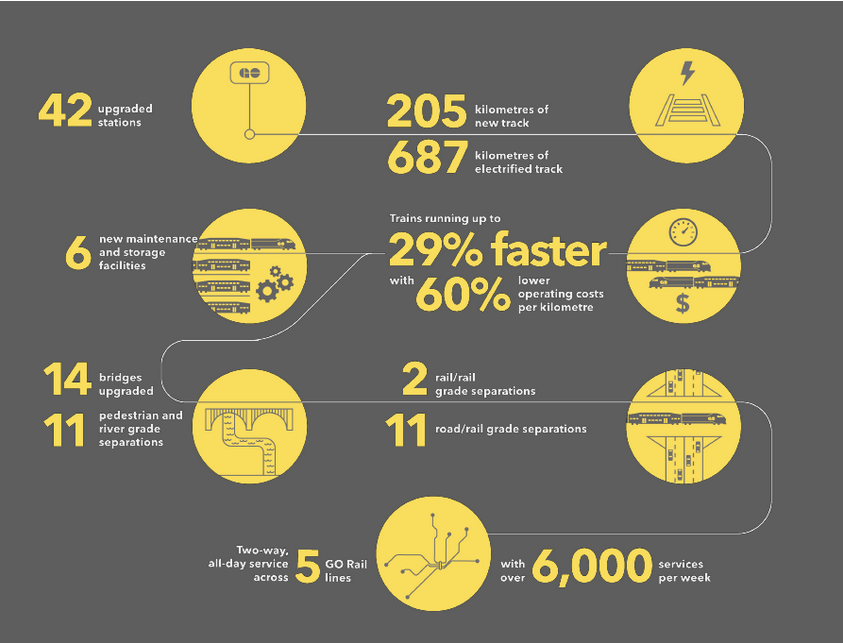 By Staff
By Staff
December 23rd, 2021
BURLINGTON, ON
There is no precedent for the GO Expansion program – it is a highly complex undertaking unlike anything before in Canada.
The largest and most complicated element of the program is the GO Expansion On-Corridor Works package, a single innovative, fully integrated contract to run more and better service. The winning team will design, build, operate, and maintain the new infrastructure and trains for 25 years, a massive, multibillion-dollar undertaking.
What does it take to completely overhaul a transit system, move people out of cars, and onto transit?
The people at GO Transit look at what the future could look like while looking over their shoulder at recent progress on the lines.
Pundits agree that frequent, convenient service is the top driver for ridership growth. Build it, and they will come, to steal a line from Field of Dreams.
GO Expansion aims to do exactly that – to provide a regional transit system so convenient, that the additional four million residents that will move to the region by 2041, will find taking the train a lot more convenient than driving a car.
It’s hard to contemplate what it may mean to GO Transit customers to see trains pulling into stations every 15 minutes or less, in either direction. The closest comparison is Toronto’s TTC subway system, where riders simply walk to the station, with no need to check the train schedule.
GO Transit – the commuter transit service – will be gone, transformed to the equivalent of a surface subway system for travel all day, every day, for any kind of trip.

GO Expansion includes adding over 200 km of new track, electrifying over 600 km of track, a new electric train fleet will combine to become the largest transit project in North America. (Metrolinx graphic)
The GO Expansion On-Corridor Works package — known as ‘OnCorr’ to those in the industry— is the central piece that builds on all the other parts of GO Expansion to make that vision a reality.
The successful proponent team will be responsible for delivering 15 minute or better, all-day service on our core lines. That means a train turning up every 15 minutes or less in each direction at every station between Union and Burlington on the Lakeshore West line, Union and Bramalea on the Kitchener line, Union and Bradford on the Barrie line, Union and Unionville on the Stouffville line, and Union and Oshawa on Lakeshore East.
To operate those service levels, safely and reliably, the successful proponent team will need to design and build the right improvements to GO’s infrastructure.
This includes implementing overhead electrification, upgrading train control systems, and expanding tracks and structures along the corridors to allow for 6,000 weekly train trips. These infrastructure improvements will complement the billions of dollars of GO Expansion Early Works projects already underway or complete, as well as planned work renovating existing stations, building new stations and extending the GO rail network to places like Bowmanville in the future.
The contract is in a multi-year procurement process, and the bids closed on Nov. 30.

An artist’s rendering of an electric GO train, subject to change. (Metrolinx image) They will be all electric, quieter, much easier on the environment
Two proponent teams, EnTransit and ONxpress Transportation Partners, have submitted their proposals.
Each team brings together international firms with extensive experience building and running frequent electric regional rail networks outside North America with local partners.
EnTransit
– Keolis Canada Inc.
– Keolis SA;SNC-Lavalin Constructors (Pacific) Inc.
– SNC-Lavalin Inc.
– SNC-Lavalin Operations & Maintenance Inc.
– SNCF Participations
– Hitachi Rail STS Canada Inc.
– Engie Transport CM Canada Inc.
– Eiffage Génie Civil
TSO ONxpress Transportation Partners
– Aecon Concessions, a division of Aecon Construction Group Inc.
– Aecon Infrastructure Management Inc.
– Aecon O&M, a division of Aecon Construction Group Inc.
– ALSTOM Transport Canada Inc.
– ALSTOM Holdings SA
– Deutsche Bahn International Operations GmbH
– Hatch Corporation
– FCC Construccion S.A.
– WSP Canada Inc.
Benefits of GO Expansion:
GO Expansion will provide a major new travel choice to customers and significantly increase transit ridership, cut trip times, and help manage congestion across the GTHA
Time savings (faster, more frequent, and reliable transit options throughout the region)
Congestion management (similar transit services throughout the world have been shown to slow the growth of road congestion)
Financial savings (transit fares typically cost less than owning and maintaining a vehicle)
Easier movement of people and goods to address estimated yearly congestion costs of up to $11 billion
What’s Next?
Over the next several months, Infrastructure Ontario and Metrolinx will evaluate the proposals.
Metrolinx and Infrastructure Ontario will announce the winning team in Spring 2022, and there will be a 24-month development phase after the contract is awarded, where Metrolinx and the successful proponent will work collaboratively on design, early investigations, schedule optimization, and key initial construction work.
Construction is expected to start in late 2022 or early 2023, subject to the successful proponent’s construction schedule.
















Has Doug Ford (“Mr. 413”) heard about this?
Sounds very nice but like every Metrolinx project so far will far exceed costs estimates and gobble up taxpayer dollars.